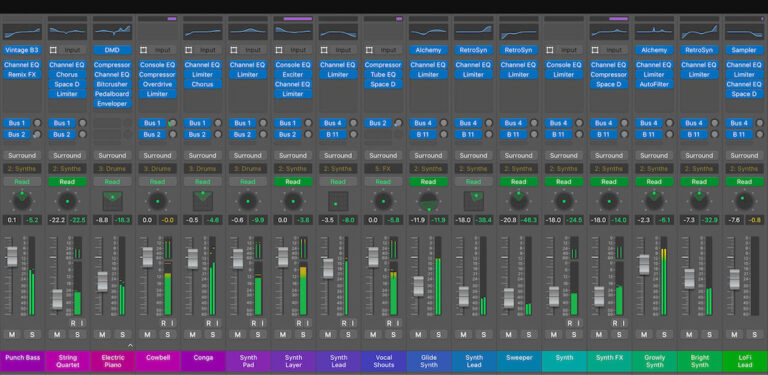In the creative industries we are constantly bombarded with inspiring messages along the lines of ‘Less is more’ and ‘Keep It Simple’. However, if we talk about music production, sometimes one instrument alone might not be enough to create the lush, rich, bigger than life sound that you want on your track. You might have heard of ‘Layering’, a technique that consists of stacking two or more sounds together to make them work as a single but more powerful and unique sound.
And even if this sounds simple and straightforward, it’s definitely not, so we have collected some tips that will help you get better at it. As per usual in the realms of music production, the following tips are not going to turn you into a pro sound designer overnight, but they will definitely help you to get on the right path and achieve better results quickly.

1. Your main layer needs to be solid on its own
This might seem a bit obvious, but when layering sounds, most of the time there will be one particular layer which is the main ingredient, sounding louder than the rest. Then other layers will add certain characteristics to it, being the additional or extra layers.
Always make sure that the main layer, the sound you pick or create first, is as solid as possible in terms of timbre and frequencies, and make it as close to the final sound in your head as you possibly can. This will be the foundation of your group of layers, and if it’s not good enough it won’t hold the rest of them up. Then, the rest of the layers will bring specific qualities which you were not able to fit around that first sound, as we will see in the next tip.

2. Layer sounds that provide different qualities
When you have your main layer ready, think of what it might be lacking in sonic terms so that’ll be closer to the final sound you’re looking for. Maybe you want it to be fuller in certain parts of the frequency spectrum so it sounds fatter, or maybe you want to add a great sense of width or depth, or just make it more piercing. Then think of the layers you need to add to make that happen.
For instance, imagine you have a synthesized kick drum with a solid low-end and a piercing attack. Sounds pretty good already, but it lacks some texture due to its electronic nature. You could try adding a layer of organic noise from foley recordings to add that real-world grit to it, giving it more character and making it more interesting.
But also consider how this new layer will merge with the original one in other aspects of sound. If your kick is already hitting hard, maybe you can remove any transients from the new noise layer by using a slow attack in the sampler’s envelope, so the transient of the resulting sound doesn’t go too far up and interfere with its dynamics.

Another example: you have a plucky lead synth that plays a simple melody. It’s pretty full frequency wise, sounds really sharp, but since the notes are short and plucked, and the melody isn’t very busy, it doesn’t really fill the track the way you’d like it to. It’s also a bit thin in terms of stereo.
You could then try to synthesize a smoother layer that occurs after the plucked synth, as a kind of reverb-tail if you will. For this new layer, and to make your synth stand out, you could apply some stereo effects to it, so it creates the effect in which the sound widens up during each note. Having a different timbre or even a different reverb than the first sound can also help to make it more interesting. Or maybe you can add a new synth that is not on the same note, but a fifth up, or an octave up, so it brings different harmonics to the table.
To sum up – when layering, think of your sounds in different aspects: timbre, texture, frequency content, volume over time, pitch, space, width, depth… This will help you figure out how you can make it more interesting.

3. Don’t overdo it
When starting to apply this type of technique, it’s pretty easy to get carried away and start adding too many layers, messing with the resulting sound, and sometimes even the entire mix of your track. There’s a few steps you can take to check you’re not overdoing it:
- Mute your layers one by one to make sure that each one of them is adding something relevant to the layered resulting sound. If you’re doing this in the context of a full track, do this process with the whole mix on, not on solo, so you can detect if some layers are unnecessary in the context of the track or even masking other elements.
- If you’re playing with different stereo width layers, try collapsing the final result to mono just to make sure that there’s no major phase issues that can cause parts of the sound to disappear due to phase cancellations when listening in mono sound systems.
- Layering can be done in different points of production, but don’t be too drastic if you’re at an early stage of your project. If you’re working on the first sound of your track, it’s not really smart to start adding many layers to it. You won’t be able to judge how good the layering is since there won’t be any other elements to compare how big, wide, or fat a sound is. Not only that, but if you make a sound too big or fat, you will have trouble later when you try adding new musical elements to the mix.
As always, when you have to make decisions, use your ears and remain mindful of what sounds best. Experiment with different synths, foley sounds, parallel processing, extreme effects… sometimes, unexpected results can become great layers that add that final magic touch to your sounds.






 50 Industry Music Production Tips You Must Know
50 Industry Music Production Tips You Must Know




